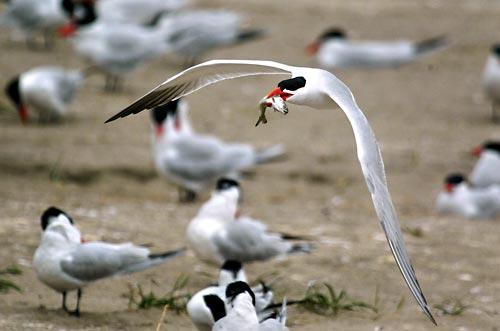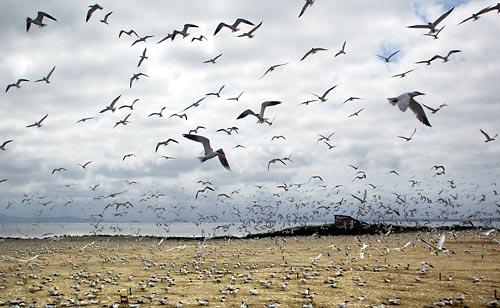forum
library
tutorial
contact

Corps Prepares for Battle with Hungry Birds
by Bill RudolphNW Fishletter, December 12, 2013
|
the film forum library tutorial contact |

|
Corps Prepares for Battle with Hungry Birdsby Bill RudolphNW Fishletter, December 12, 2013 |
 The Corps of Engineers' Walla Walla Division has completed a draft environmental assessment of its proposed plan to improve ESA-listed juvenile salmonid survival in the mid-Columbia region by reducing avian predation and accepted public comment until Dec. 2.
The Corps of Engineers' Walla Walla Division has completed a draft environmental assessment of its proposed plan to improve ESA-listed juvenile salmonid survival in the mid-Columbia region by reducing avian predation and accepted public comment until Dec. 2.
The process to study and curb bird predation was an element in the 2008 hydro BiOp. Since then, researchers have found that a colony of more than 400 breeding pairs of Caspian terns at Goose Island in the Potholes Reservoir was responsible for eating more than 100,000 salmonid smolts in 2010. Between 9 percent and 29 percent of the total was young steelhead.
More work completed in 2011 estimated that the tern colony ate 11 percent of the Upper Columbia wild steelhead and nearly 15 percent of the hatchery steelhead that were migrating down the river, along with 3 percent of the spring chinook run.
In 2012, the birds consumed 17 percent of the steelhead run, which scientists said coincided with higher numbers of breeding pairs of terns at the colony.
Another tern colony under scrutiny is located at Crescent Island, near the mouth of the Snake River, below Pasco, Wash. In 2010, the 400-plus breeding pairs of terns from this site were estimated to have consumed 420,000 juvenile salmonids. About 13 percent of that total was made up of steelhead.
PIT tag detections at the colony also found that the birds ate 5 percent of inriver migrating Snake River steelhead, about 3 percent of the upper-C hatchery steelhead, and 2 percent of its wild steelhead.
The Crescent Island terns also nailed more than one percent of the inriver migrating Snake River fall Chinook, but less than one percent of the spring run, and about 1.3 percent of the non-transported sockeye.
 If both colonies could be completely relocated, the Corps says, the upper-C hatchery steelhead populations could get a boost of more than 14 percent, and nearly as much for the wild component, along with a 2- to 3-percent bump for wild and hatchery chinook. That translates into an annual increase in population growth of 4.2 percent for the hatchery steelhead, 3.2 percent for the wild component and 0.7 percent for upper-C spring Chinook.
If both colonies could be completely relocated, the Corps says, the upper-C hatchery steelhead populations could get a boost of more than 14 percent, and nearly as much for the wild component, along with a 2- to 3-percent bump for wild and hatchery chinook. That translates into an annual increase in population growth of 4.2 percent for the hatchery steelhead, 3.2 percent for the wild component and 0.7 percent for upper-C spring Chinook.
Why would steelhead benefit so much more from the proposed "dissuasion" strategy? Juvenile steelhead migrate closer to the river's surface, so are much easier for birds to catch. But the real question is how likely would Corps' efforts be successful at getting rid of the terns?
The agency's preferred alternative calls for hazing the birds as well as implementing strategies to reduce nesting, like stringing up 3-foot-high plastic screens that deter the birds from building nests because it reduces their ability to spot predators going after their eggs. But the Corps would like some of those eggs as well. Its preferred alternative calls for a limited 200-egg-take strategy, which was found to be successful in the lower Columbia at reducing tern numbers.
But the environmental assessment makes no predictions on the relative success of the proposed strategy. It does assume that no "compensatory mortality" will occur, which means the agency isn't planning on seeing some other group of birds come along and take the place of the terns in the pecking order on the mid-Columbia salmon smorgasbord.
This sort of species replacement has been seen before. In the lower Columbia, terns were harassed and eventually moved off one island to another further downstream, where their impacts on young salmon were expected to lessen. But large numbers of double-crested cormorants took over as the largest avian predators of salmonids in the estuary. The Corps has been forced to develop another plan to reduce impacts from the cormorants, even though their diets include many other kinds of juvenile fishes.
The Corps says other upriver bird colonies don't seem to harbor much of a future threat, but some cormorants do nest in the inland Columbia Basin, along with California white pelicans, California gulls, and ring-beaked gulls at 18 different colonies in 12 geographic regions.
Between 2004 and 2009, 93,000 water birds were estimated to nest in the inland basin, consuming more than one million salmonid smolts annually. That's not much compared to avian consumption in the estuary (more than 20 million smolts annually by cormorants alone) but the Corps says inland colonies can be much more dependent on salmonids for food than downriver colonies.
"The greater reliance on salmonids, in tandem with a lower diversity of salmonid stocks in comparison to the estuary, is responsible for the unexpectedly high impact on salmonids," the draft EA states.
learn more on topics covered in the film
see the video
read the script
learn the songs
discussion forum
